Brassica oleracea var. alboglabra
If you are a fan of broccoli and kale, you will love growing Chinese broccoli!
This flavorful broccoli-like green vegetable – also known as gai lan, kailaan, or Chinese kale – is simple to grow and only takes a couple of months from seed to harvest.
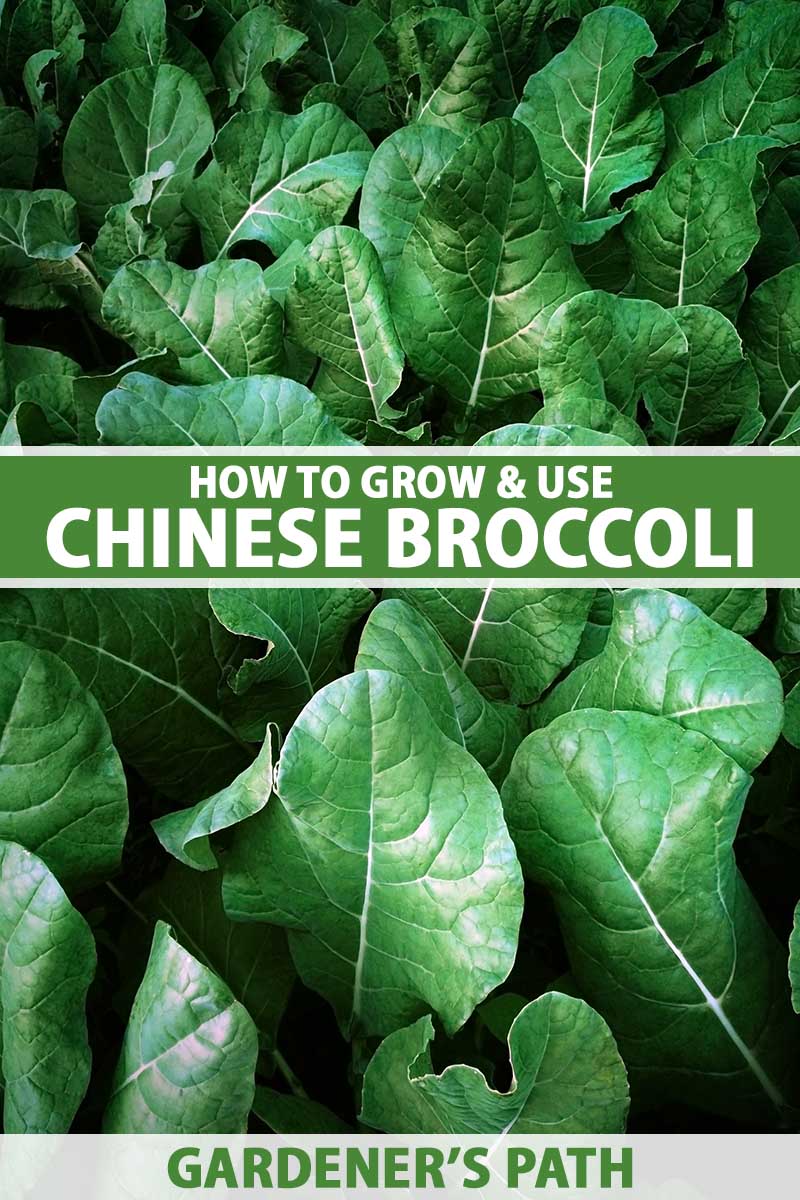
We link to vendors to help you find relevant products. If you buy from one of our links, we may earn a commission.
The best part is that the leaves, florets, and stalks are all edible, and delicious!
Continue reading to learn all about growing Chinese broccoli in your garden.
Here’s what I’ll cover:
What You’ll Learn
What Is Chinese Broccoli?
This perennial leafy green is typically grown as an annual, and is suited to USDA Hardiness Zones 2 through 10.
Tolerant of heat as well as mild frosts, it can be planted in spring and summer in cooler climates, and over the winter in Zones 9 and 10.
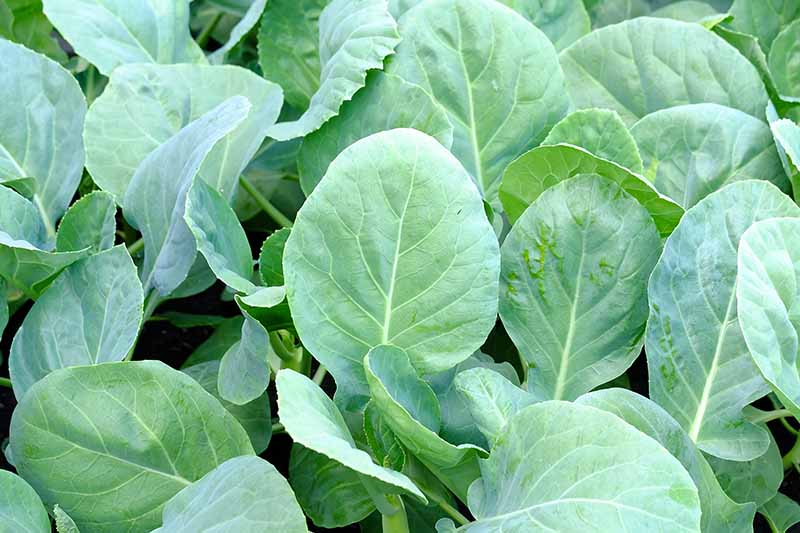
Gai lan is a brassica family plant that’s similar in appearance and flavor to broccoli, though slightly more bitter.
It has a central fleshy stalk, flat and glossy blue-green leaves, and small florets that emerge from the center.
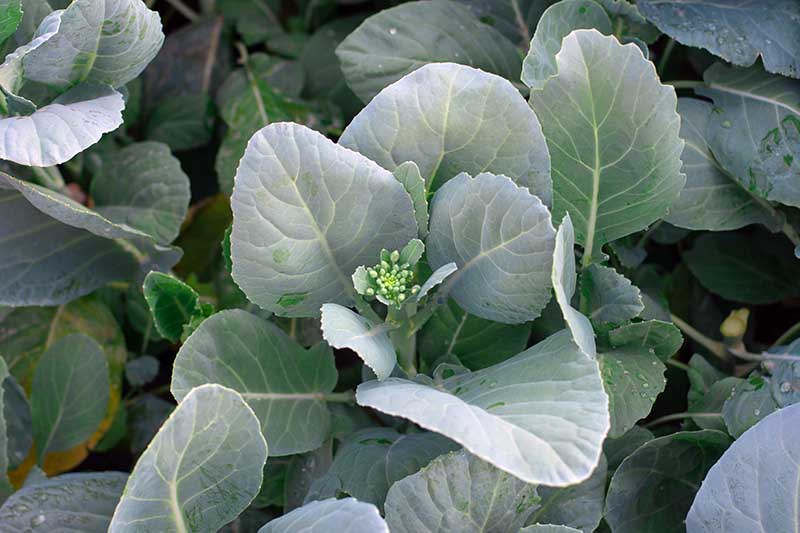
All parts of the plant are edible. The young flowering shoots and small leaves may be eaten both raw and cooked. It is often served as a wilted greens side dish in Chinese cuisine.
Cultivation and History
Gai lan is one of the most common vegetables consumed across China and Southeast Asia.
Its similarities to broccoli and other brassicas indicate that it was likely developed in cultivation over time through selection from cole crops brought to Asia by early Portuguese explorers.
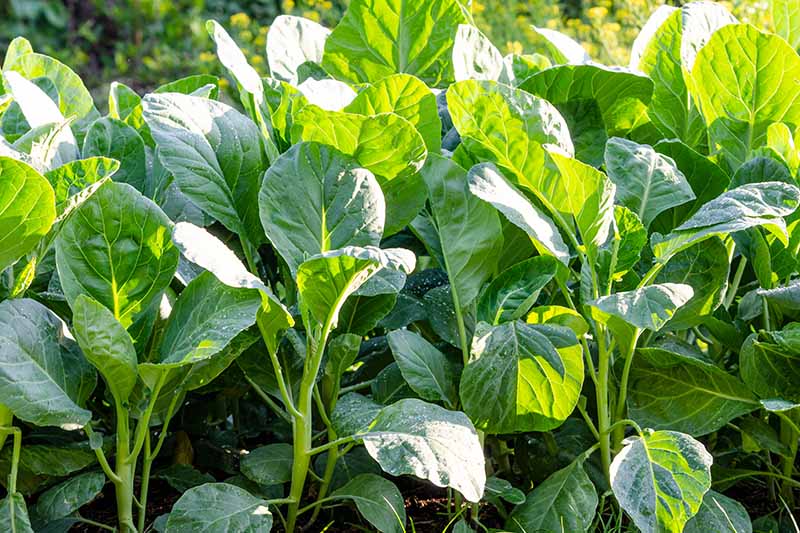
It is now widely available at specialty markets across the world, though you probably won’t find it in your typical US grocery store.
There you are much more likely to come across broccolini, which is actually a hybrid of Chinese broccoli and broccoli that was created in the ‘90s. You can read more about growing broccolini here.
Like other brassicas, Chinese broccoli is packed with nutrients like vitamins A, C, and K, as well as important minerals including potassium, calcium, and magnesium.
These help to support the immune system and eye health, among other benefits.
Propagation
Chinese broccoli can easily be grown from seed, and may be planted as soon as the soil can be worked in spring. It can even be planted over winter in mild climates where the ground doesn’t freeze.
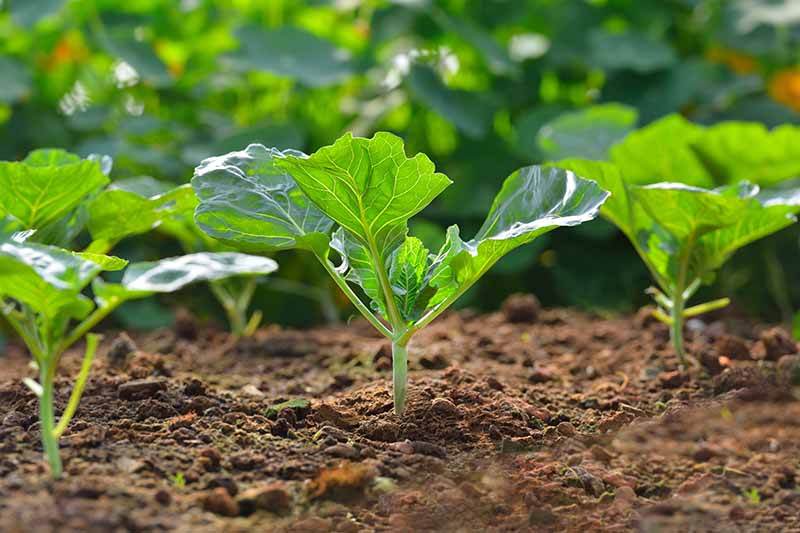
In a garden bed amended with compost, direct sow seeds a quarter-inch deep in rows spaced 18 to 24 inches apart.
Plant a seed every couple of inches, and once the seedlings are a few inches tall, thin to four to six inches. Keep the soil evenly moist until germination occurs.
A fantastic cut-and-come-again crop, seeds can be succession planted every few weeks for a continual harvest all season.

It is also possible to sow indoors in trays and transplant out once plants are three inches tall, with two sets of true leaves.
Be aware that some sources advise against starting from transplants as they tend to bolt prematurely.
If you do decide to grow from transplants, plant seeds a quarter-inch deep in flats or two-inch pots filled with an all-purpose potting soil.
Keep seedlings in a sunny location and mist daily to keep the medium moist.

Prior to planting out in the garden, be sure to harden off your seedlings by setting them outside in a protected area with indirect sun for increasing lengths of time over the period of a week or so, until they can stay outdoors all day.
You can plant starts out in the garden any time after the threat of a hard frost has passed. If you want to get an early start, use a row cover to warm the ground, insulate plants, and encourage faster growth.
This vegetable tastes best when grown in cool weather, and is tolerant of light frosts.
To transplant, dig a hole as deep as the root ball, spacing every six inches in rows two feet apart. Water well after planting.
How to Grow
Find a location in the garden that receives full sun or part shade. Plants need six to eight hours of sun a day, but keep in mind that they may bolt if the weather gets too hot.
If you live in a warm climate or are planting in the heat of summer, some shade may be helpful.
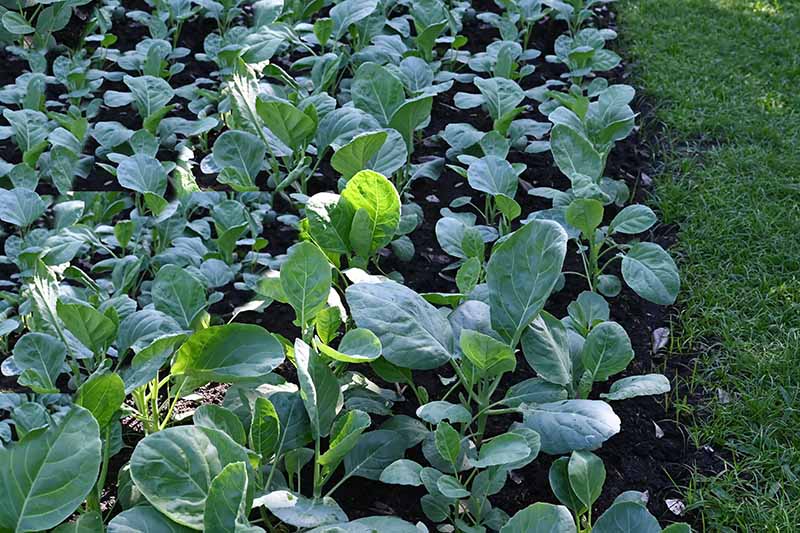
Prior to planting starts or seeds, work compost or aged manure into the top six inches of the soil. While these plants can grow in most types of soil, they do best in sandy loam.
No matter the type, the soil should be well-draining with a pH between 6.0 and 6.8.
Plants need one inch of water a week, more if it is hot and dry. Mulching around the base with straw, wood shavings, or grass clippings will help to retain water and keep the soil cool to prevent early bolting.
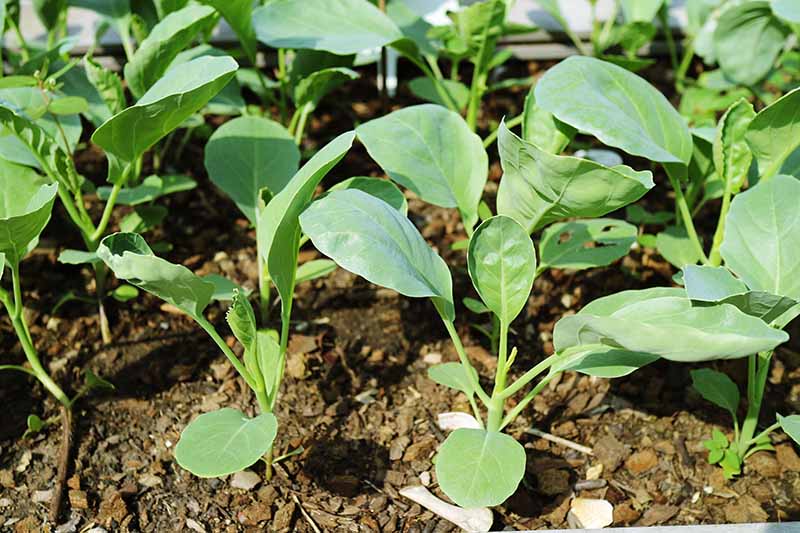
A few weeks after planting, you can also side-dress with compost, or feed with a foliar spray of compost tea or well-balanced organic fertilizer, to promote leafy growth.
Learn more about making and using compost tea in our guide.
These plants are easy to grow in containers. Plant seeds or starts in a pot at least six inches wide and deep in a well balanced potting mix, and thin seedlings to one plant per six inch pot.
Set the pot in a sunny spot in the yard or on the deck, and care for it as described above.
Growing Tips
- Plant in full sun or part shade.
- Amend soil with compost prior to planting.
- Provide one inch of water per week.
- Mulch around the base of plants to prevent bolting.
Where to Buy
You may come across a few varieties, though seeds are not typically marketed as being different cultivars. Some may have white flowers, others are yellow.
Some may reach two feet tall while others only grow about eight inches.
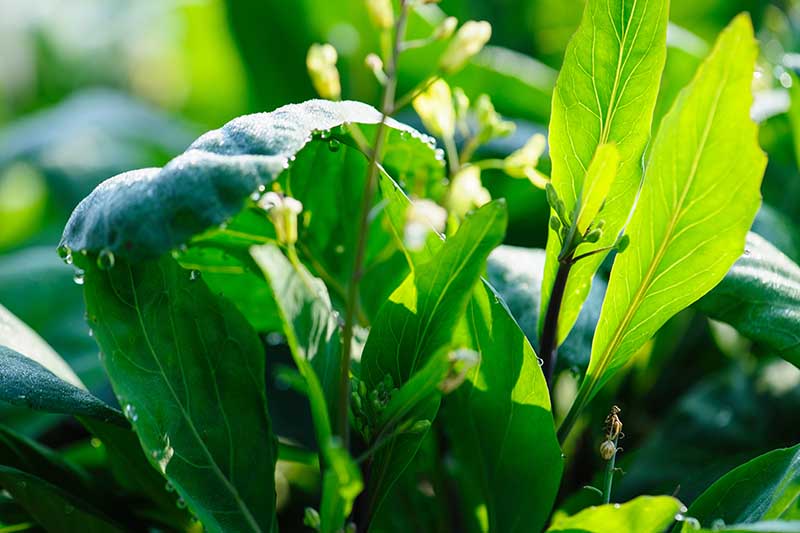
Chinese broccoli seeds can be tricky to find. In the US, it is much more common to come across hybrids such as broccolini.
A word of caution if you opt to purchase seeds from unfamiliar sources: you may wind up receiving a hybrid or other variety you didn’t expect.
It is a good idea to always read reviews and be sure the scientific name appears somewhere on the seed packet to be sure.
Brassica oleracea var. alboglabra Seeds
Fortunately, I did find B. oleracea var. alboglabra seeds available for purchase from Botanical Interests.
These come in 750-milligram packets, and the plants will reach two feet or more at maturity.
Managing Pests and Disease
As with any cole family crop, there are several pests and diseases that may cause issues for your plants.
Understanding what signs to look for and taking preventative measures can help to reduce the risk of problems down the road.
Pests
Brassicas are tasty. Unfortunately, many garden pests agree.
Keep a regular eye on your plants, and try to keep them separated from others in the same family. That way, if pests do discover your crop, you can more easily keep infestations from spreading.
Here are the most common varieties of insects and gastropods you may encounter:
Aphids
These may be found congregating on the undersides of leaves to suck out the sap, leaving behind sticky honeydew that attracts ants and sooty mold.
Severe aphid infestations slow growth, leading to wilt and sometimes the death of your crop. Aphid infestations tend to be worse during periods of cool and dry conditions.
Try spraying plants with a hard stream of water from the hose. You can also spray infested plants with soapy water or insecticidal soap every couple of days, until infestations subside.
Cabbage Loopers
Moths of the species Trichoplusia ni lay their eggs on the underside of foliage, and the resulting little green caterpillars eat their way through the leaves.
Infestations can grow rapidly and quickly decimate entire plants.
Keep an eye on the leaves, regularly checking both the tops and the undersides. Remove any cabbage loopers you find by hand daily.
Large infestations may be controlled with applications of Bacillus thuringiensis, which can be purchased from Arbico Organics.
Learn more about how to manage cabbage loopers in our guide.
Cutworms
These pesky larvae come out at night to feed, eating through the stems of seedlings. Prevention is the best measure for dealing with them, since the worms can be difficult to control once they are grown.
Since the adult moths lay their eggs on dead plant material, removing weeds and other debris prior to planting can help reduce the risk of an infestation.
You can also protect seedlings with barriers made from toilet paper rolls sunk a couple of inches deep into the soil.
If an infestation occurs, you can try removing cutworms by hand in the evening, or sprinkle diatomaceous earth around the base of your plants.
Read more about dealing with cutworms in the garden here.
Slugs and Snails
These pests may come out to eat the tender parts of the plant, especially after periods of rainy weather.
If you aren’t too squeamish, you can handpick these slimy pests to remove them. Cups full of beer sunk into the soil also work well to lure slugs away from plants.
Reducing mulch applications and keeping weeds down may also help to reduce the presence of gastropods in your veggie patch.
Read more about dealing with slugs and snails in the garden in our guide.
Disease
Chinese broccoli plants are susceptible to several types of bacterial and fungal diseases. With many of these, the best method of control is prevention.
The risk of most infections can be greatly reduced by rotating crops, providing good air circulation, and avoiding overhead watering. Here are a few common conditions to be on the lookout for:
Bacterial Leaf Spot
Caused by P. syringae pv. maculicola bacteria, this pathogen creates small lesions on leaves which grow over time, eventually causing foliage to die. It is common during cool, wet weather and is spread by splashing water.
Rotate crops annually and avoid overhead watering to prevent bacterial leaf spot. Infected foliage should be removed and discarded.
Bacterial Soft Rot
Caused by bacteria in the Pectobacterium genus, symptoms include small lesions which grow rapidly and cause plants to become brown and decay. Warm and wet weather is ideal for this soilborne bacteria to thrive.
To prevent a bacterial soft rot infection, avoid overhead watering and rotate crops.It is also important to only harvest in dry weather since this bacteria spreads easily in wet conditions.
Infected plants should be removed and destroyed.
Club Root
This disease, caused by Plasmodiophora brassicae fungi, causes root swelling and wilting, leaving infected plants vulnerable to other soilborne pathogens.
Roots become misshapen, and may appear cracked and rotten. Plants with club root may be stunted or die off completely.
Unfortunately, there are no effective control methods available. Be sure to always use clean tools when handling plants infected with club root to avoid spread, and remove infected plants.
Damping Off
Young plants are most susceptible to this fungal disease. Caused by a number of different species of soilborne fungi, damping off is a serious condition that can cause stems and roots to rot.
There is no cure available for infected plants, and they should be removed and disposed of. You can greatly reduce the risk of this fungal disease by providing adequate drainage and good airflow.
Downy Mildew
The fungus Peronospora parasitica causes yellow and brown lesions to form on foliage, as well as visible white spores. Mildew can stunt plant growth and cause foliage to drop.
Downy mildew is common in wet, cool weather. As preventive measures, keep weeds down and provide ample space between plants to improve airflow, and avoid overhead watering.
Remove and destroy infected foliage.
Harvesting
The leaves, florets, and stalks can all be harvested and eaten.
Flowers are technically edible as well, though the key is to harvest when plants are young, as older leaves and flowers can become very bitter.
Expect to begin harvesting about 60 days after planting.

A cut-and-come-again crop, you want to begin picking when the florets first emerge from the center stalk just before the flowers start to open.
Cut six to eight inches of the center stem along with the floret and several young leaves.
Leaving a few inches of stem and leaves attached to the stalk will encourage side shoots to develop. You should be able to harvest again in a few weeks.
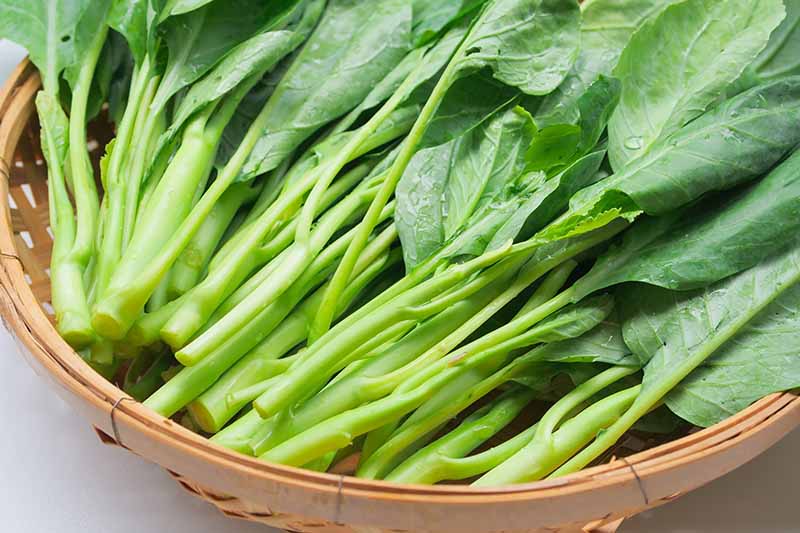
It is also possible to harvest the entire plant if you wish, cutting the stem at the base.
To harvest and save seeds, allow a healthy plant to go to flower and form seedpods. Wait for the pods to mature and dry before harvesting.
Once they are ready to pick, cut the stalks near the base, and hang them upside down in a cool dark location for another couple of days to be sure they are completely dry.
Use your hands to open the pods and collect the seeds. Store in paper bags or airtight containers in a cool, dry, and dark place until you are ready to plant them.
Preserving
Be sure to refrigerate or use your harvest immediately, as gai lan is quick to wilt.
I prefer to harvest just before cooking for maximum freshness. If you aren’t able to do this, Chinese kale can be stored in the fridge for up to five days in an unsealed plastic bag in the crisper drawer.
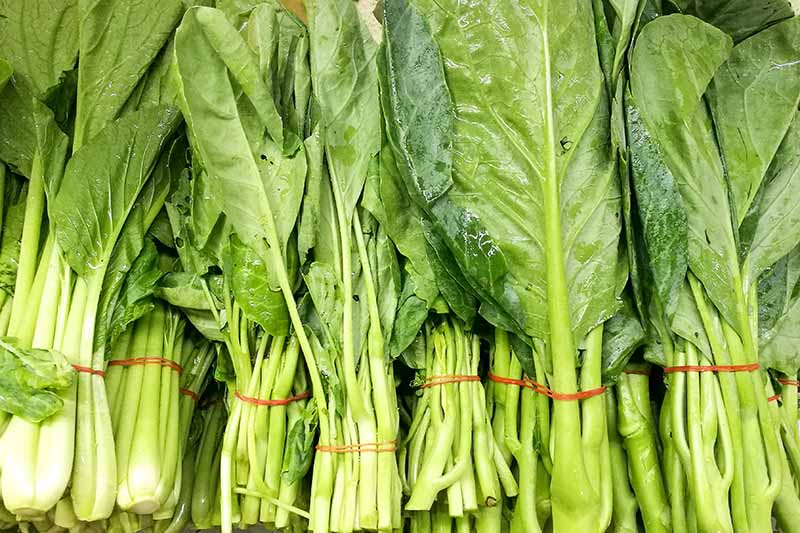
To freeze for longer storage, wash thoroughly and blanch in boiling water for three minutes.
Depending on your preference, this can be done with the whole stem with leaves intact, or they may be chopped into one- to two-inch pieces.
Just remove any older woody stalks prior to blanching.
Quickly chill in ice water and drain thoroughly. Spread in a single layer on a baking sheet lined with parchment paper and flash freeze for an hour. This should keep frozen pieces from sticking together.
Store in freezer bags for up to six months.
Recipes and Cooking Ideas
The best part about this plant is that the stalk, unopened flower buds, and leaves are edible and pleasantly sweet, with a slightly bitter, earthy flavor.
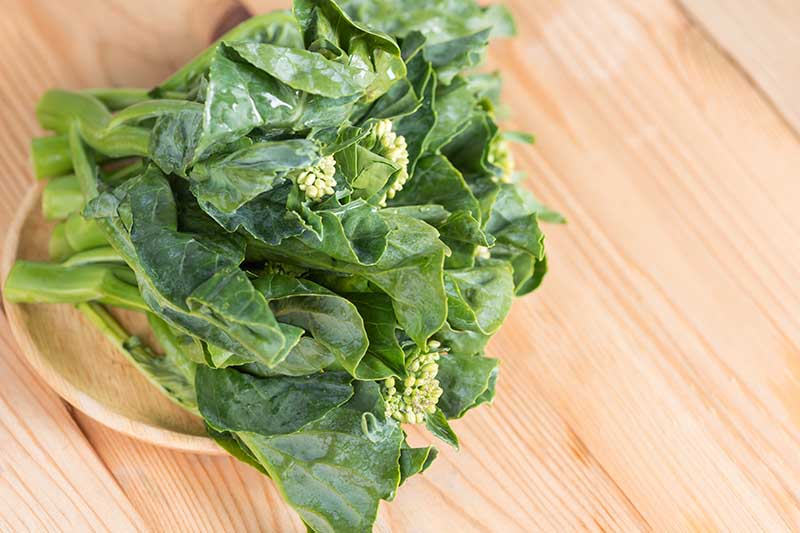
It is best to use the young shoots and leaves. If you do decide to cook older stems, just note that they should be peeled first. Leaves also become tougher and more bitter with age.
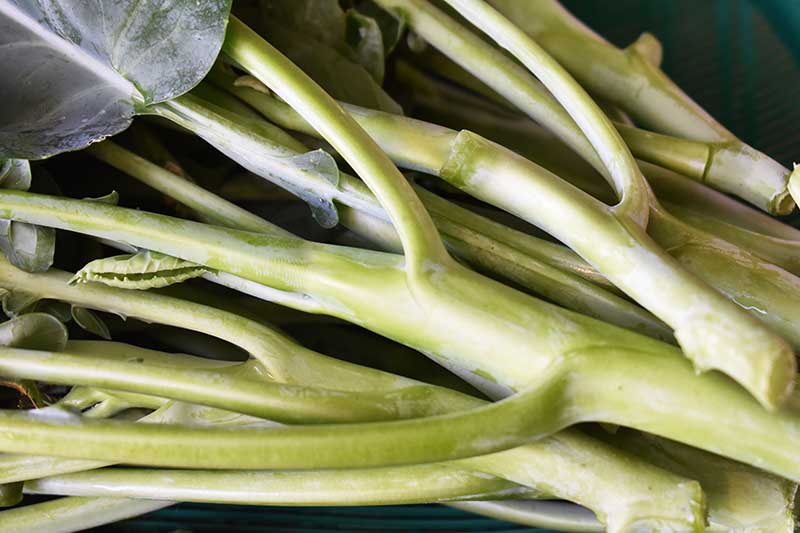
Chinese broccoli can be eaten raw in salads, but it is traditionally prepared by either steaming, boiling, or stir frying. It is often served with oyster sauce, or it can be wilted in broth-based soups.
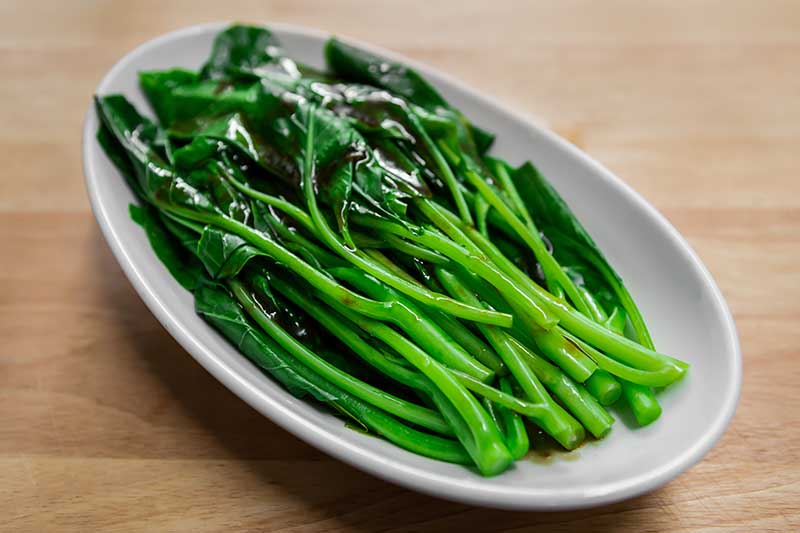
Its tender texture and supurb flavor makes gai lan a perfect addition to Asian stir fries.
You can use it in any recipe that calls for broccoli, such as this recipe for chicken and shrimp lo mein on our sister site, Foodal.
This dish is jam-packed with protein and veggies served in a flavorful sauce, and best of all, it can be prepared in a single pan.
Quick Reference Growing Guide
| Plant Type: | Perennial vegetable grown as annual | Maintenance: | Low |
| Native to: | Mediterranean | Tolerance: | Heat, light frost |
| Hardiness (USDA Zone): | 2-10 | Soil Type: | Sandy loam |
| Season: | Spring-fall, winter in Zones 9-10 | Soil pH: | 6.0-6.8 |
| Exposure: | Full sun-part shade | Soil Drainage: | Well-draining |
| Time to Maturity: | 60 days | Attracts: | Pollinators, if allowed to flower |
| Spacing: | 6 inches | Companion Planting: | Celery, dill, lettuce, potatoes, onions, radishes |
| Planting Depth: | 1/4 inch (seeds), depth of root ball (transplants) | Avoid Planting With: | Other brassicas |
| Height: | 8-36 inches | Family: | Brassicaceae |
| Spread: | 12 inches | Genus: | Brassica |
| Water Needs: | Low to moderate | Species: | Oleracea |
| Common Pests and Disease: | Aphids, cabbage loopers, cutworms, slugs, snails; bacterial leaf spot, bacterial soft rot, club root, damping off, downy mildew | Variety: | Alboglabra |
No Part Wasted
It’s always exciting to try growing something just a little bit different. And this ultra-flavorful and tender vegetable is certainly deserving of the spotlight. I especially love that I can eat the whole thing!
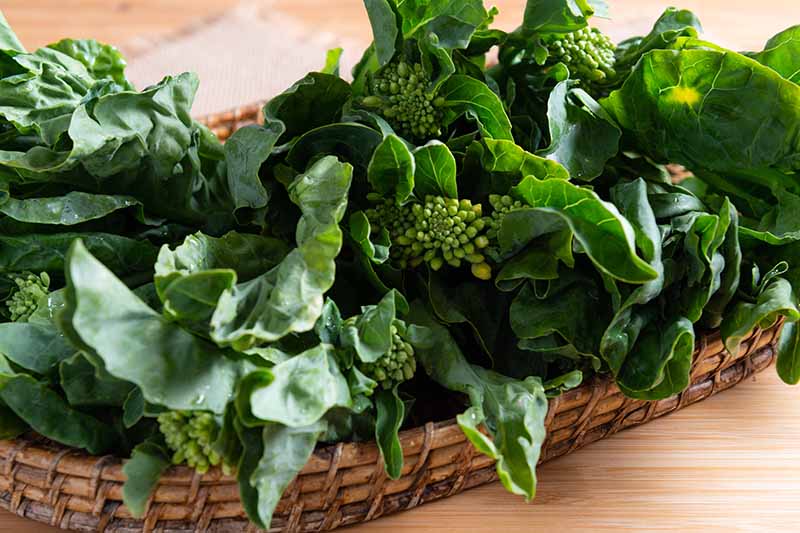
What do you love about growing Chinese broccoli? Share your stories in the comments below!
If you enjoyed learning about this vegetable, check out these articles for information on growing other cole crops next:
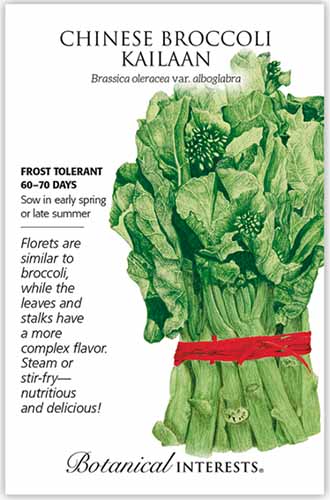
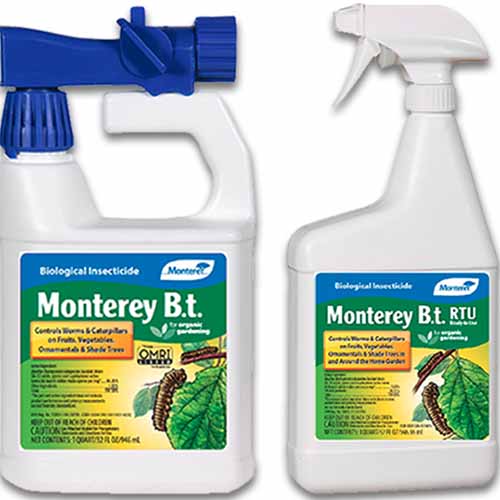

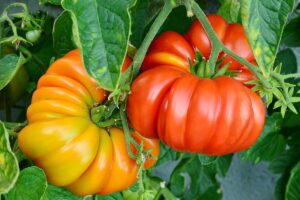
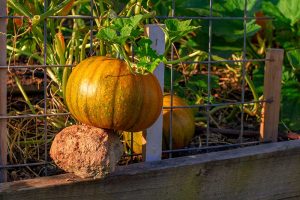
Thank you for this information! I wondered if Chinese broccoli was a one and done harvest and have learned it CAN be a cut and come again veggie. I grew this once before but now I am confused about the difference between this and YOD FAH which I have also grown. We preferred one over the other as it was sweeter, grew taller and didn’t bolt as fast as the other. i can’t distinguish between the two in my mind and I should have made better notes. Can you tell me the difference between the two plants as they are… Read more »
Can Chinese broccoli be frozen?
Yes, find instructions in the Preserving section of the article above.